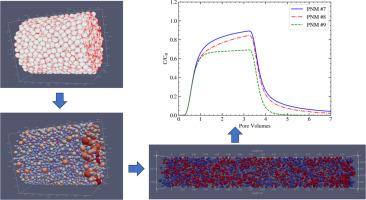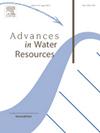纳米粒子在部分饱和多孔介质中的传输:流体界面的附着
IF 4
2区 环境科学与生态学
Q1 WATER RESOURCES
引用次数: 0
摘要
与固-水界面(SWI)一样,气-水和油-水界面(AWI 和 OWI)也是多孔介质中纳米颗粒的收集器。疏水性纳米颗粒的附着通常是有利的且不可逆的,这一点尤其引人关注,因为此类颗粒的迁移和滞留与纳米塑料在非饱和地下环境中的命运以及纳米补救措施的成功与否密切相关。在此,我们展示了如何利用孔隙网络模型(PNM)来放大单一流体-流体界面上不可逆纳米粒子在球状填料的平流和分散条件下的附着动力学和程度。通过关注被困(不移动)的非润湿相,我们强调了 AWI/OWI 和 SWI 的单收集器接触效率之间的根本区别。也就是说,AWI/OWI 收集器在很大程度上被流动的水相绕过,暴露在以扩散为主的水动力环境中。这种差异对于在连续(达西)尺度上模拟多孔介质中的纳米粒子传输有着深远的影响。这项研究揭示了孔隙网络建模的潜力,它是连续介质模型的重要补充,可用于放大纳米胶体在多孔介质中的行为。本文章由计算机程序翻译,如有差异,请以英文原文为准。

Nanoparticle transport in partially saturated porous media: Attachment at fluid interfaces
Like the solid-water interface (SWI), air-water and oil-water interfaces (AWI and OWI) also act as collectors for nano-sized particles in porous media. The attachment of hydrophobic nanoparticles, which is often favorable and irreversible, is of particular interest because the transport and retention of such particles is closely linked to the fate of nanoplastics in unsaturated subsurface environments and the success of nanoremediation practices. Here, we show how a pore-network model (PNM) can be used to upscale the kinetics and extent of irreversible nanoparticle attachment at a single fluid-fluid interface under conditions of advection and dispersion in a sphere packing. By focusing on a trapped (immobile) non-wetting phase, we highlight a fundamental difference between the single-collector contact efficiency of AWI/OWI and SWI. Namely, AWI/OWI collectors, which are largely by-passed by the flowing aqueous phase, are exposed to a hydrodynamic environment dominated by diffusion. This difference has profound implications for the modelling of nanoparticle transport in porous media at the continuum (Darcy) scale. This study reveals the potential of pore network modelling as an essential complement to continuum models for upscaling the behavior of nanocolloids in porous media.
求助全文
通过发布文献求助,成功后即可免费获取论文全文。
去求助
来源期刊

Advances in Water Resources
环境科学-水资源
CiteScore
9.40
自引率
6.40%
发文量
171
审稿时长
36 days
期刊介绍:
Advances in Water Resources provides a forum for the presentation of fundamental scientific advances in the understanding of water resources systems. The scope of Advances in Water Resources includes any combination of theoretical, computational, and experimental approaches used to advance fundamental understanding of surface or subsurface water resources systems or the interaction of these systems with the atmosphere, geosphere, biosphere, and human societies. Manuscripts involving case studies that do not attempt to reach broader conclusions, research on engineering design, applied hydraulics, or water quality and treatment, as well as applications of existing knowledge that do not advance fundamental understanding of hydrological processes, are not appropriate for Advances in Water Resources.
Examples of appropriate topical areas that will be considered include the following:
• Surface and subsurface hydrology
• Hydrometeorology
• Environmental fluid dynamics
• Ecohydrology and ecohydrodynamics
• Multiphase transport phenomena in porous media
• Fluid flow and species transport and reaction processes
 求助内容:
求助内容: 应助结果提醒方式:
应助结果提醒方式:


